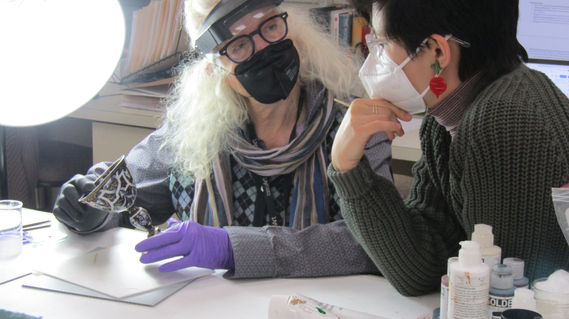
Elle Friedberg

Before treatment, normal illumination.

GOBLET WITH BACCHIC PROCESSION
Painted enamel on copper with gilt decoration
Materials
c. 1560
Year
Attributed to Pierre Reymond
Maker
Collection
Philadelphia Museum of Art
This goblet depicts the mythical Roman scene of The Triumph/Cortege of Bacchus, the god of wine and agriculture.
The goblet was made in the city of Limoges in central France. Limoges is well known for its production of enameled metal objects since the Middle Ages. Limoges enamels were primarily produced by a small number of families including the Pènicaud, Limosin, and Reymond families. The scene on goblet derives from a print by Jacques Androuet du Cerceau published in Orleans around 1546.
There were several precursors to the development of the painted enamels from the twelfth to fifteenth centuries which involved creating an image relied on boundaries in the metal used to separate the areas of color. It was not until the late fifteenth to early sixteenth centuries when a revised method was developed that allowed artists to paint enamels more freely. The copper support was instead used as an open surface for applying enamel like a canvas for painting.
Before treatment, normal illumination.
Image: Jason Wierzbicki, Conservation Photographer
CONDITION BEFORE TREATMENT
-
Several areas of visually distracting repairs from previous treatment campaigns including fills, overpaint, and adhesive residues on the surface.




Before treatment.
After overpaint removal.
After fill removal.
After addition of Flugger fill.
After inpainting.

X-ray radiograph showing internal rod.
After inpainting.

Before treatment, long-wave UV illumination image showing old adhesive and repairs which fluoresce bright white and yellow.
KEY TREATMENT STEPS
-
Carried out scientific analysis: x-ray radiography
-
Removed overpaint, previous fills, and excessive adhesive
-
Filled losses with Flugger
-
Inpainted Flugger fills with Golden Fluid Acrylics followed by Primal WS24 tinted with Orasol dyes.

Additional images. Use arrows to scroll and click on images to expand.
TREATMENT RESULTS

Before treatment.

After treatment.
Image: Jason Wierzbicki, Conservation Photographer


